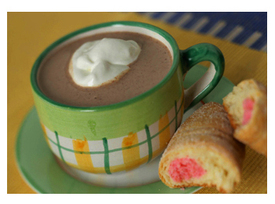Champurrado. Cham-purrrrr-ado. It’s sounds so fiesty. At it’s most loose it is a hot chocolate and spice drink that is thickened with corn meal. As a member of a group of Mexican corn-based drinks called atoles it is a most often compared to the Eastern-based milk tea, chai.
In it's simplest form it is milk and piloncillo, a type of brown sugar, is brought to a boiling point while the masa harina is browned in a skillet. So simple but such a complex earthy taste. Due to it’s somewhat filling nature it can be served as a late afternoon merienda (snack) or as a simple breakfast with churros. However it is during Christmas time posadas where it is served alongside tamales that you’ll find huge pots and big crowds.
Not to wander too much here but…in 16th century Mexico, Aztecs celebrated the arrival of Huitzilopochtli, the war god, from Dec. 7 to 24. During the time of the Spanish missionaries this celebration was replaced with the European Christmas traditions to replace the pagan images with those of Mary and Joseph. Posada, a Christmas festival which plays out the search of Joseph and Mary seeking lodging, are celebrated in churches and missions with dramatic representations of the Nativity scene.
It’s probably one of the first fusion foods with the Spaniards milk and sugar marrying with the native corn of Mexico. The secret to making this comforting traditional beverage is to continually stir. The consistency should be thicker than that of hot chocolate.
Champurrado
Chocolate Atole
Adapted from California Rancho Cooking by Jacqueline Higuera McMahan
1/3 cup ground masa harina
1 tablespoon cornstarch
½ cup water
4 cups milk
¾ cup dark brown sugar, firmly packed
Dash of cinnamon
1 ounce bittersweet or semisweet chocolate, chopped
1 tspn vanilla extract
Instructions: Add the masa harina and cornstarch to the cold water and whisk to dissolve all the lumps. Add the mixture to the milk and brown sugar in a saucepan deep enough to allow room for whisking. Stir over low heat. Once the champurrado has begun to slightly thicken, after 10 minutes, add the chocolate, cinnamon, and vanilla bean. The tiny granules of corn should take about 20 minutes to well and thicken up. All at once it will seem, the liquid will become smooth and velvet like. Serve with the cinnamon stick. Serves 4



Hello, I am from Tashkent, the capital of Uzbekistan,
I am very interested in making cakes. Our family has a little factory that produces cakes, but now we want to promote it by finding an international partner. If you are interested in having business in Middle Asia I offer you to be partners. I will wait an answer from you on my e@mail
Posted by: Rustam | January 23, 2007 at 10:22 PM
I'm from the Philippines and we have a chocolate dish that is similarly named but spelled commonly as champorrado. Unlike this dish however, the Philippines version uses rice which is the staple here. Mexico and the Philippines do share a common heritage with Spanish conquistadores traipsing about our lands in the distant past. Champurrado similarly is cooked with sugar, dark semi or sweetened chocolate, and sticky (malagkit) rice, a variety that produces more starch than most. Served for breakfast or as merienda (snack) and paired with a salty companion as dried sardine (tuyo) fried crisp or dried and salt cured beef strips (fried crisp as well) to provide a contrasting texture to the smooth pasty consistency of the champorrado. The milk is poured over the dish much in the way you would cream your coffee.
Posted by: Carlos Maglutac | February 01, 2007 at 02:51 PM
I can personally attest to the deliciousness of this thick elixir.
Thank you for putting a recipe for it out there in the universe. Maybe someday someone else I know will make it....
Posted by: shuna fish lydon | February 08, 2007 at 10:30 PM
I usually use Abuelitas chocolate instead of dark brown sugar, chocolate and vanilla extract. I've also been told to boil cinnamon sticks until the water is red to get that flavor in it. Yum!
Posted by: Heather | November 27, 2007 at 12:38 PM